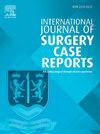Ossifying fibroma of the nasal cavity: Case report and literature review
IF 0.6
Q4 SURGERY
引用次数: 0
Abstract
Introduction and importance
Ossifying fibroma is a benign, encapsulated, or demarcated neoplasm consisting of varying amounts of cementum-like tissue or bone within a fibrous tissue stroma. It commonly affects patients aged 20 to 40 years, with a predominance in females; however, it can also affect children and adolescents. In this case report, we will present a rare instance of ossifying fibroma in the nasal cavity.
Case presentation
A 25-year-old female, a known case of B-cell lymphoma diagnosed in 2022 and treated with chemotherapy, was referred to ENT for an abnormal CT finding. The CT showed a complex lesion in the left nasal cavity with peripheral calcification and extension to the left maxillary sinus, left frontal sinus, and ethmoidal air cells. The remaining paranasal sinuses were well-aerated, and no associated bony destruction was found.
Clinical discussion
The appearance of ossifying fibroma lesions in the nasal cavity is uncommon. In the literature, most cases of ossifying fibroma are typically found in sites such as the mandible and maxilla. It usually present as a painless bony mass that can give rise to symptoms depending on the site affected. The mainstay management is primarily surgical. It is suggested that without complete removal of the lesion, recurrence can occur between 6 months to 7 years after resection.
Conclusion
Ossifying fibroma is a benign bony lesion that most commonly affects the mandible and maxilla. It primarily occurs in females during their second to fourth decades of life. Such lesions are usually asymptomatic until they grow large enough to cause symptoms. Management for such tumor is primarily surgical to avoid recurrence.
求助全文
约1分钟内获得全文
求助全文
来源期刊
CiteScore
1.10
自引率
0.00%
发文量
1116
审稿时长
46 days

 求助内容:
求助内容: 应助结果提醒方式:
应助结果提醒方式:


